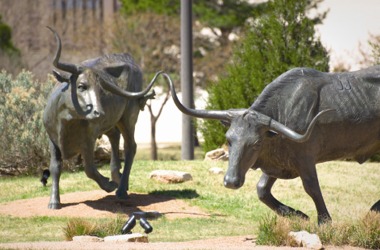Lubbock

Today Lubbock is a thriving, bustling city of over 218,000 people, but 200 years ago, the area was covered with tall grasses and roaming buffalo. The region was first discovered and named the Llano Estacado in 1540 by the infamous Spanish explorer Coronado on his quest for the "City of Gold."
Lubbock began as two smaller towns until 1890 when "Old Lubbock" and "Monterey" joined together, on a new site, to establish a town consisting of 50 people. This new town, named after Tom S. Lubbock, a Confederate officer, Texas Ranger, and signer of the Texas Declaration of Independence, became the county seat less than a year after being established and officially became a city in 1909. That same year, Lubbock residents saw for the first time dark pillars of billowing smoke on the horizon as the first train pulled into Lubbock from Plainview.
Lubbock, the county seat of Lubbock County, is located at the approximate center of the county.. The city, the largest on the South Plains, is on Interstate Highway 27, 327 miles northwest of Dallas and 122 miles south of Amarillo. Lubbock was founded as a part of the movement westward onto the High Plains of Texas by ranchers and farmers. More directly it was the result of a compromise between two groups of town promoters, one led by Frank E. Wheelock and the other by W. E. Rayner. In the fall of 1890 these groups abandoned their settlements, known respectively as Old Lubbock and Monterey, and agreed on December 19 of that year to combine into the new settlement. In 1876 the county had been named for Thomas S. Lubbock, former Texas Ranger and brother of Francis R. Lubbock, governor of Texas during the Civil War. As early as 1884 a federal post office called Lubbock existed at George W. Singer's store in Yellow House Canyonqv, in the northern part of the present-day city.
One of the first orders of business of the town promoters was to circulate a petition for the organization of the county. At the resulting election on March 10, 1891, Lubbock was duly elected county seat, and its permanence was assured. Settlers began to arrive. The town's first newspaper, the Lubbock Leader, began publication on July 31, 1891. Within three years the town had six lawyers and as many stores, a dentist, three land agents, a livery stable, two hotels, including the Nicolett, which had been moved across the canyon from the original settlement, and the county courthouse and jail. The jail also housed the school taught by Miss Minnie Tubbs, and there the Quakers, Baptists, and Methodists had begun holding regular services by the summer of 1891. Within a few years Lubbock had already begun to establish itself as a marketing center on the South Plains. But with its dusty, unpaved streets, its scattered rows of small wooden houses, each with its own windmill, and blasted by periodic dust storms, the town had little to distinguish it from scores of other rural settlements on the plains.
